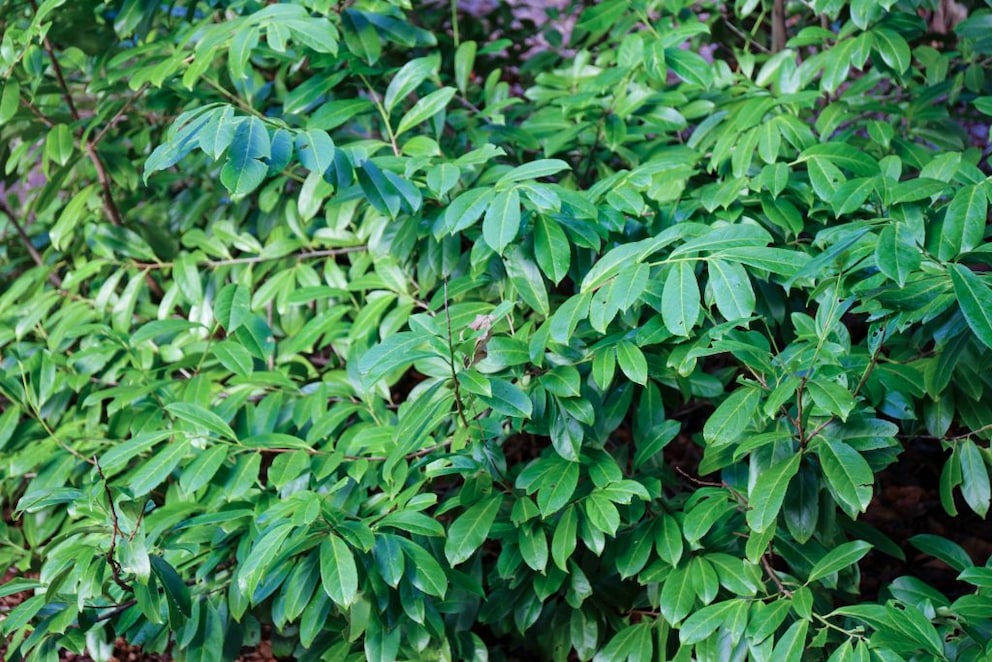May 22, 2025, 1:45 pm | Read time: 3 minutes
Cherry laurel, as an evergreen plant, is among the most popular garden plants. It is especially favored as a hedge plant. While generally low-maintenance, yellow leaves are a clear sign that action is needed. They indicate that the plant is not doing well.
Year-round, the cherry laurel, also known as the laurel cherry, provides an evergreen ornament with its glossy leaves. The white flowers in spring and the red fruits in late summer add to the plant’s appeal. With evergreen plants, it is particularly noticeable when the leaves suddenly turn yellow. It’s likely not a good sign. What yellow leaves on cherry laurel mean and how gardeners should respond is explained here.

Dense, Fast-Growing, Evergreen – 14 Popular Hedge Species for the Garden

What to Do When Strawberry Leaves Turn Yellow

What to Know if You Want to Plant Sweet Cherries
Why Cherry Laurel Gets Yellow Leaves
Prunus laurocerasus, the botanical name for cherry laurel, is generally a robust and easy-care plant. However, if yellow or brown discolorations appear on the leaves, there can be various causes. In overly dense soil, for example, waterlogging can quickly occur. This can lead to plant diseases and root rot. In such cases, the cherry laurel must be carefully dug up, and the soil loosened with sand. The plant can then be replanted. Additionally, the following issues can be problematic:
Drought
The plant generally copes well with shorter, dry weather periods. However, cherry laurel develops yellow leaves if there has been no rain for an extended period or if it has not been sufficiently watered. The tricky part: Cherry laurel remains steadfastly green for a long time, enduring the stress of drought and heat. The discoloration usually appears only when the soil is sufficiently moistened again. As robust as it is, cherry laurel should be regularly watered. Mulching with leaves or grass clippings also helps protect against poor weather and provides the plant with sufficient nutrients.
Nutrient Deficiency
Sometimes, mulching is not enough to provide cherry laurel with sufficient nutrients. Especially in the cold season, yellow leaf veins or yellow-brown leaves quickly appear. To meet the nutrient needs, a commercial special fertilizer for hedges helps. The mineral fertilizer should be rich in iron and nitrogen. In spring, cherry laurel can also be supplied with compost.

Shot Hole Disease
If unsightly holes appear in the leaves alongside yellow discolorations, it indicates shot hole disease. While it can be challenging for young plants, well-established cherry laurels can cope with the disease. Nevertheless, affected leaves and plant parts should be removed. The cuttings should be disposed of in household waste. If diseased leaves end up in the compost, the fungal disease could spread again in the garden. Additionally, spraying with a fungicide helps. Gardening expert Karl Ploberger suggests that alternatively, the plant can be treated with horsetail extract. This can strengthen the plant from within.
Sunburn
In a full-sun location in the garden, cherry laurel can suffer from leaf burn. Ploberger also points this out. Especially on overly dry soil, the leaves then curl and turn yellow rather than brown. In such cases, the plant should be thoroughly watered, and severely damaged leaves removed. Varieties with smaller leaves are more robust against intense sun than cherry laurels with large leaves. This also applies to bright winter sun during dry conditions.
Even in the cold season, the laurel cherry should be watered regularly as long as there is no ground frost. Additionally, covering with a fleece helps. In autumn, cherry laurel can be strengthened with a potassium special fertilizer to prevent impending frost damage.

